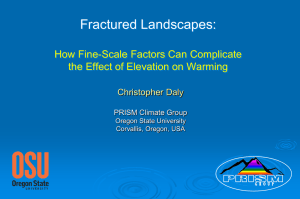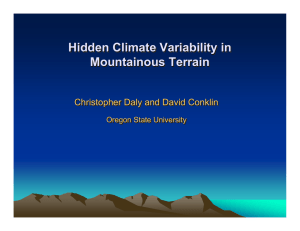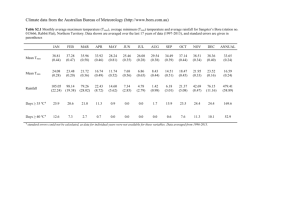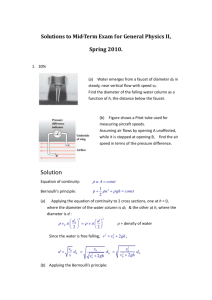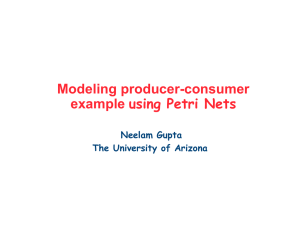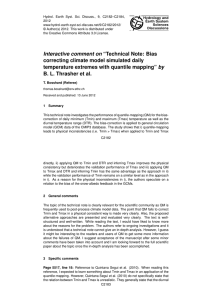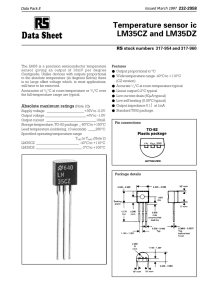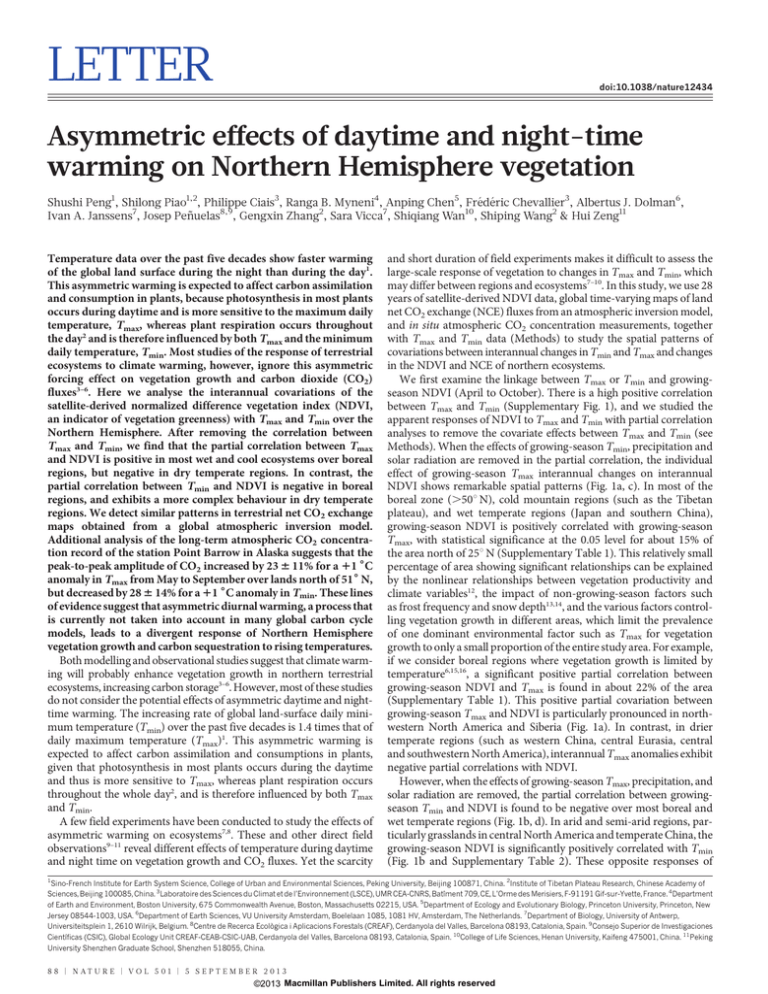
LETTER
doi:10.1038/nature12434
Asymmetric effects of daytime and night-time
warming on Northern Hemisphere vegetation
Shushi Peng1, Shilong Piao1,2, Philippe Ciais3, Ranga B. Myneni4, Anping Chen5, Frédéric Chevallier3, Albertus J. Dolman6,
Ivan A. Janssens7, Josep Peñuelas8,9, Gengxin Zhang2, Sara Vicca7, Shiqiang Wan10, Shiping Wang2 & Hui Zeng11
Temperature data over the past five decades show faster warming
of the global land surface during the night than during the day1.
This asymmetric warming is expected to affect carbon assimilation
and consumption in plants, because photosynthesis in most plants
occurs during daytime and is more sensitive to the maximum daily
temperature, Tmax, whereas plant respiration occurs throughout
the day2 and is therefore influenced by both Tmax and the minimum
daily temperature, Tmin. Most studies of the response of terrestrial
ecosystems to climate warming, however, ignore this asymmetric
forcing effect on vegetation growth and carbon dioxide (CO2)
fluxes3–6. Here we analyse the interannual covariations of the
satellite-derived normalized difference vegetation index (NDVI,
an indicator of vegetation greenness) with Tmax and Tmin over the
Northern Hemisphere. After removing the correlation between
Tmax and Tmin, we find that the partial correlation between Tmax
and NDVI is positive in most wet and cool ecosystems over boreal
regions, but negative in dry temperate regions. In contrast, the
partial correlation between Tmin and NDVI is negative in boreal
regions, and exhibits a more complex behaviour in dry temperate
regions. We detect similar patterns in terrestrial net CO2 exchange
maps obtained from a global atmospheric inversion model.
Additional analysis of the long-term atmospheric CO2 concentration record of the station Point Barrow in Alaska suggests that the
peak-to-peak amplitude of CO2 increased by 23 6 11% for a 11 6C
anomaly in Tmax from May to September over lands north of 516 N,
but decreased by 28 6 14% for a 11 6C anomaly in Tmin. These lines
of evidence suggest that asymmetric diurnal warming, a process that
is currently not taken into account in many global carbon cycle
models, leads to a divergent response of Northern Hemisphere
vegetation growth and carbon sequestration to rising temperatures.
Both modelling and observational studies suggest that climate warming will probably enhance vegetation growth in northern terrestrial
ecosystems, increasing carbon storage3–6. However, most of these studies
do not consider the potential effects of asymmetric daytime and nighttime warming. The increasing rate of global land-surface daily minimum temperature (Tmin) over the past five decades is 1.4 times that of
daily maximum temperature (Tmax)1. This asymmetric warming is
expected to affect carbon assimilation and consumptions in plants,
given that photosynthesis in most plants occurs during the daytime
and thus is more sensitive to Tmax, whereas plant respiration occurs
throughout the whole day2, and is therefore influenced by both Tmax
and Tmin.
A few field experiments have been conducted to study the effects of
asymmetric warming on ecosystems7,8. These and other direct field
observations9–11 reveal different effects of temperature during daytime
and night time on vegetation growth and CO2 fluxes. Yet the scarcity
and short duration of field experiments makes it difficult to assess the
large-scale response of vegetation to changes in Tmax and Tmin, which
may differ between regions and ecosystems7–10. In this study, we use 28
years of satellite-derived NDVI data, global time-varying maps of land
net CO2 exchange (NCE) fluxes from an atmospheric inversion model,
and in situ atmospheric CO2 concentration measurements, together
with Tmax and Tmin data (Methods) to study the spatial patterns of
covariations between interannual changes in Tmin and Tmax and changes
in the NDVI and NCE of northern ecosystems.
We first examine the linkage between Tmax or Tmin and growingseason NDVI (April to October). There is a high positive correlation
between Tmax and Tmin (Supplementary Fig. 1), and we studied the
apparent responses of NDVI to Tmax and Tmin with partial correlation
analyses to remove the covariate effects between Tmax and Tmin (see
Methods). When the effects of growing-season Tmin, precipitation and
solar radiation are removed in the partial correlation, the individual
effect of growing-season Tmax interannual changes on interannual
NDVI shows remarkable spatial patterns (Fig. 1a, c). In most of the
boreal zone (.50u N), cold mountain regions (such as the Tibetan
plateau), and wet temperate regions (Japan and southern China),
growing-season NDVI is positively correlated with growing-season
Tmax, with statistical significance at the 0.05 level for about 15% of
the area north of 25u N (Supplementary Table 1). This relatively small
percentage of area showing significant relationships can be explained
by the nonlinear relationships between vegetation productivity and
climate variables12, the impact of non-growing-season factors such
as frost frequency and snow depth13,14, and the various factors controlling vegetation growth in different areas, which limit the prevalence
of one dominant environmental factor such as Tmax for vegetation
growth to only a small proportion of the entire study area. For example,
if we consider boreal regions where vegetation growth is limited by
temperature6,15,16, a significant positive partial correlation between
growing-season NDVI and Tmax is found in about 22% of the area
(Supplementary Table 1). This positive partial covariation between
growing-season Tmax and NDVI is particularly pronounced in northwestern North America and Siberia (Fig. 1a). In contrast, in drier
temperate regions (such as western China, central Eurasia, central
and southwestern North America), interannual Tmax anomalies exhibit
negative partial correlations with NDVI.
However, when the effects of growing-season Tmax, precipitation, and
solar radiation are removed, the partial correlation between growingseason Tmin and NDVI is found to be negative over most boreal and
wet temperate regions (Fig. 1b, d). In arid and semi-arid regions, particularly grasslands in central North America and temperate China, the
growing-season NDVI is significantly positively correlated with Tmin
(Fig. 1b and Supplementary Table 2). These opposite responses of
1
Sino-French Institute for Earth System Science, College of Urban and Environmental Sciences, Peking University, Beijing 100871, China. 2Institute of Tibetan Plateau Research, Chinese Academy of
Sciences, Beijing 100085, China. 3Laboratoire des Sciences du Climat et de l’Environnement (LSCE), UMR CEA-CNRS, Batı̂ment 709, CE, L’Orme des Merisiers, F-91191 Gif-sur-Yvette, France. 4Department
of Earth and Environment, Boston University, 675 Commonwealth Avenue, Boston, Massachusetts 02215, USA. 5Department of Ecology and Evolutionary Biology, Princeton University, Princeton, New
Jersey 08544-1003, USA. 6Department of Earth Sciences, VU University Amsterdam, Boelelaan 1085, 1081 HV, Amsterdam, The Netherlands. 7Department of Biology, University of Antwerp,
Universiteitsplein 1, 2610 Wilrijk, Belgium. 8Centre de Recerca Ecològica i Aplicacions Forestals (CREAF), Cerdanyola del Valles, Barcelona 08193, Catalonia, Spain. 9Consejo Superior de Investigaciones
Cientı́ficas (CSIC), Global Ecology Unit CREAF-CEAB-CSIC-UAB, Cerdanyola del Valles, Barcelona 08193, Catalonia, Spain. 10College of Life Sciences, Henan University, Kaifeng 475001, China. 11Peking
University Shenzhen Graduate School, Shenzhen 518055, China.
8 8 | N AT U R E | VO L 5 0 1 | 5 S E P T E M B E R 2 0 1 3
©2013 Macmillan Publishers Limited. All rights reserved
LETTER RESEARCH
a
c
1
0.27
R
–0.27
–0.40
–0.51
–1
b
d
0.40
0.34
R
0
–0.27
–0.40
–0.51
–1
1,000
800
600
400
200
0
3
2
1
6 5
7 5
7 4 8
8 2 4 4
13 5 12 3
7 4 2 7
–20
4
4
7
6
10
10
4
6
6
4
12
2
3
2
4
4
3
13
14
3
3
1
5
5
9
9
11
7
9
4
3
2
5
13
17
24
15 13
4 16 8
8
–10
0
10
20
30
Mean annual temperature (°C)
50
60
70
80
90
100
100
90
80
70
60
50
60
70
80
90
Negative
–0.34
1,200
1
2
1
0
2
60
Fraction (%)
0.27
1,400
70
Positive
0.51
Mean annual precipitation (mm yr–1)
1
80
Negative
–0.34
90
Fraction (%)
0.34
Mean annual precipitation (mm yr–1)
0.40
100
Positive
0.51
0
1
9
10
1,200
5 3 8 2
7 5 3 4
1,000
12 20 4 3
19 31 5 12
800
18 32 7 9
26 25 30 6 7
600
19 32 23 9 4 2
13 32 37 23 15 5 3
400
28 15 15 25 3 6 7 3
30 17 26 17 4 4 8 4 11
200
19 3 14 7 8 8 7 5 19 19
10
0
–20
–10
0
10
20
30
Mean annual temperature (°C)
1,400
100
Figure 1 | The response of growing-season (from April to October) NDVI to
changes in growing-season maximum temperature (Tmax) and minimum
temperature (Tmin) in the Northern Hemisphere. a, Spatial distribution of
the partial correlation coefficient R between growing-season NDVI and Tmax
after controlling for Tmin, precipitation and solar radiation. b, Spatial
distribution of R between growing-season NDVI and Tmin after controlling for
Tmax, precipitation and solar radiation. The labels on the colour bars in a and
b, R 5 60.51, R 5 60.40, R 5 60.34 and R 5 60.27 correspond to the 1%, 5%,
10% and 20% significance levels, respectively. Among the five night-time
warming experiments sites marked in b, the results of four sites—Mols in
Denmark (pentagram), Clocaenog in United Kindom (square), Garraf in Spain
(circle) and Duolun in China (cross)—are consistent with the result of the
partial correlation analysis between NDVI and Tmin (Supplementary Table 2;
the site of Oldebroek in the Netherlands was marked by a diamond in b).
c, Percentage of pixels with dominant (positive pixels .50% or negative pixels
.50%) partial correlation between NDVI and Tmax (shown in a) in each 5 uC
interval of mean annual temperature and 100-mm interval of mean annual
precipitation climate space. d, Same as c but for the partial correlation between
NDVI and Tmin shown in b. The right colour bars in c and d indicate the
fraction of pixels with dominant partial correlation between growing-season
NDVI and Tmax/Tmin, and the numbers in each interval climate space of c and
d indicate the percentage of pixels with significant partial correlation (for
example, if the percentage of pixels with positive partial correlation exceeds
50%, the space is blue and the number is the percentage of pixels with positive
and significant partial correlation, but if the percentage of pixels with positive
partial correlation is less than 50%, the space is brown and the number is the
percentage of pixels with negative and significant partial correlation).
NDVI to Tmin between the wet and dry regions of the Northern
Hemisphere is supported by some previous studies. For instance, an
increase in Tmin was found to reduce rice yields by 10% per uC in the
Philippines10, but to enhance growth at a temperate dry grassland site
in China8.
To test the robustness of our analysis, we also applied an independent statistical test called the ridge regression method17. The results show
spatial patterns of the NDVI response to Tmax and Tmin similar to
those obtained with a multiple-linear method (Supplementary Fig. 2).
Nevertheless, the absolute magnitude of the sensitivities of NDVI to
Tmax and Tmin is smaller in the ridge regression results. Patterns for the
correlation between NDVI and Tmin or Tmax similar to those displayed
in Fig. 1 were also obtained when using different growing-season definitions (May–October and May–September; Supplementary Figs 3
and 4), and using other gridded data sets of solar radiation, precipitation (or vapour pressure deficit as the moisture surrogate), instead of
the climate data set from the Climate Research Unit (CRU) of the
University of East Anglia, UK (Supplementary Figs 5–10). Finally, to
test for possible spurious spatial correlations patterns that could be due
to the spatial interpolation of meteorological station data in the CRU
gridded data set, we performed the same correlation analyses using
observed records from 1,736 individual meteorological stations available over the last three decades (Methods) and found the same pattern
as in Fig. 1 (see Supplementary Figs 11 and 12).
Covariance between climate variables, regressed with NDVI, especially between Tmax and Tmin (Supplementary Fig. 1), could affect the
interpretation of our partial correlation analyses. We therefore performed reduced partial correlation analyses separately using either
Tmax, precipitation and solar radiation or Tmin, precipitation and solar
radiation. The results show that the reduced partial correlation coefficients between NDVI and Tmin (statistically controlling precipitation
and solar radiation, but not Tmax) have the same sign as between NDVI
and Tmax (statistically controlling precipitation and solar radiation, but
not Tmin), but with different strengths in most areas (Supplementary
Fig. 13). In boreal ecosystems, the NDVI–Tmax correlation is higher
than the NDVI–Tmin correlation, but in the dry temperate ecosystems
it is lower. This result again confirms a differential response to warming; for example, boreal ecosystems respond more to increases in Tmax
than to increases in Tmin.
Additionally, to minimize the effect of collinearity between Tmax and
Tmin in a multiple linear regression statistical model, we also replaced
them with their average (Tmean 5 (Tmax 1 Tmin)/2) and difference
5 S E P T E M B E R 2 0 1 3 | VO L 5 0 1 | N AT U R E | 8 9
©2013 Macmillan Publishers Limited. All rights reserved
RESEARCH LETTER
(DTR 5 Tmax 2 Tmin) and performed the same partial correlation analysis. The results show that boreal NDVI positively correlates with
Tmean and DTR; whereas dry temperate NDVI exhibits negative relationships with Tmean and DTR (Supplementary Fig. 14). This is consistent with the results of partial correlation analysis with Tmax, Tmin,
precipitation and solar radiation (Fig. 1). A statistical blind test also
shows that the regression or partial correlation method used in our
study correctly captures a relationship between NDVI and Tmax or Tmin
if there is one (see Supplementary Information). Splitting the temperature signal into Tmax and Tmin thus helps the process interpretation of
these results.
Second, we analysed how variations in Tmax and Tmin may influence
interannual anomalies in the seasonal cycle of net CO2 fluxes of northern ecosystems using the atmospheric CO2 record of the stations of
Point Barrow in Alaska (71u N) and Mauna Loa in Hawaii (19u N)
(Methods). We found that the interannual variation in the amplitude
of the detrended CO2 seasonal cycle (AMP) at Point Barrow does not
significantly correlate with the Tmean of May–September averaged over a
broad boreal latitudinal zonal band (51u–90u N) (R 5 20.03, P 5 0.897);
all variables were detrended and effects of precipitation and solar radiation were removed in the partial correlation analysis. This weak correlation of AMP with Tmean, however, masks its significant but opposite
correlations with Tmax and Tmin. Indeed, multiple linear regression
analyses, using AMP at Point Barrow as the dependent variable and
detrended precipitation, solar radiation, Tmax or Tmin as independent
variables, show that AMP responds positively to positive Tmax anomalies by 3.8 6 1.9 p.p.m. per uC (23 6 11% of peak-to-peak AMP per uC
of Tmax) (R 5 0.38, P 5 0.048), but negatively to positive Tmin anomalies
by 24.8 6 2.4 p.p.m. per uC (228 6 14% of peak-to-peak AMP per uC
of Tmin (R 5 20.38, P 5 0.047); Fig. 2 and Supplementary Table 3). At
Mauna Loa, no significant partial correlation is obtained between interannual AMP variations and either the corresponding Tmax (R 5 20.02,
P 5 0.866) or the corresponding Tmin (R 5 0.02, P 5 0.893) variations
(Fig. 2), possibly owing to the mixed temperature effects across different
temperate regions (Fig. 1).
Last, we investigated the covariance between the interannual anomalies of NCE (positive values indicating net CO2 uptake by ecosystems)
and those of Tmax and Tmin using NCE gridded estimates from a global
atmospheric inversion over the last three decades18. For the boreal
region (.50u N), the inversion-based NCE from May to September is
found to respond positively to positive anomalies of Tmax, with a sensitivity of 1.1 6 0.6 Pg of C per uC (R 5 0.37, P 5 0.059), and negatively to
positive anomalies of Tmin, with a sensitivity of 21.7 6 0.7 Pg of
C per uC (R 5 20.45, P 5 0.021; Fig. 3 and Supplementary Table 4)
(1 Pg 5 1015 g). These relationships are qualitatively similar to the ones
found between AMP versus Tmax and Tmin in the boreal zone. In the
temperate latitude band (25u–50u N), the inversion-based NCE from
May to October is not significantly correlated with either Tmax
(R 5 0.11, P 5 0.604) or Tmin (R 5 20.24, P 5 0.238) (Fig. 3). Similar
patterns were also obtained when using the inversion with flat prior
information (Supplementary Fig. 15). Note that inversion NCE uncertainties are large at the grid-point scale, and that individual grid point
NCE estimates are correlated with each other. The spatial distribution
of the response of inversion NCE to Tmax and Tmin over the climatic
dimensions (Supplementary Figs 16 and 17) is comparable with that
derived from the (independent) NDVI (Fig. 1c and d). Interestingly, the
geographical area where the growing-season NCE positively correlates
with Tmax (Supplementary Figs 16 and 17) is less extensive than the area
where growing-season NDVI positively correlates with Tmax (Fig. 1).
This could be explained by a concurrent increase of soil organic matter
decomposition induced by warming in boreal and temperate regions
where water is readily available.
In summary, our analyses of several data streams consistently point
out that interannual changes in growing-season Tmax and Tmin have
regionally opposite effects on NDVI (greenness) and NCE. Daytime
positive Tmax anomalies correlate positively with enhanced photosynthetic activity (NDVI) and NCE over wet and cool ecosystems, but
have negative effects in dry temperate regions. These regionally contrasting effects of Tmax interannual variations on interannual vegetation greenness and growing-season CO2 uptake are most probably
associated with different ecophysiological responses. In boreal regions,
photosynthetic activity and NCE are subject to temperature limitation
but less subject to water limitation6,15,16. Rising Tmax has been observed
to enhance photosynthetic enzyme activity19, to increase soil nitrogen
mineralization and availability20, and to extend the growing season21.
In contrast, in dry temperate regions where soil water limitation can
limit vegetation growth, daytime warming can reduce photosynthetic
activity through enhanced evaporation, and reduced soil water content8.
The hypothesis that a drop in topsoil water content (SWC) below a
critical stress level in dry temperate regions is associated with warmer
Tmax during the growing season is consistent with the negative partial
correlation coefficients between growing-season Tmax and SWC
retrieved from multiple microwave satellite sounders over 1988–2007
(ref. 22) (Fig. 4a, Supplementary Figs 18–21).
3
Sensitivity of AMP to
temperature (% ºC–1)
40
Sensitivity of NCE to
temperature (Pg C ºC–1)
60
**
20
0
–20
–40
–60
**
Point Barrow
2
1
0
–1
–2
–3
Mauna Loa
Figure 2 | Tmax and Tmin sensitivity of annual AMP at Point Barrow and
Mauna Loa stations. The Tmax (red) and Tmin (green) sensitivity of AMP at
each station was estimated based on a multiple linear regression analysis using
detrended AMP as the dependent variable and the detrended precipitation,
solar radiation, Tmax and Tmin during the corresponding season (May–
September for Point Barrow station and May–October for Mauna Loa station)
over a broad region surrounding each station by 620 degrees of latitude (51u–
90u N for Point Barrow and 1u S–39u N for Mauna Loa) as the independent
variables. **Statistically significant at the 95% (P , 0.05) level. The error bars
are standard errors of the mean of the corresponding parameters.
*
**
Boreal
Temperate
Figure 3 | Tmax and Tmin sensitivity of a global atmospheric inversion
model estimated NCE in boreal and temperate regions. Using an approach
similar to that of Fig. 2, we calculated the sensitivity of corresponding season
NCE in boreal (50u–90u N) and temperate (25u –50u N) regions to changes in
Tmax and Tmin (May–September for boreal regions and May–October for
temperate regions). The Tmax (red) and Tmin (green) sensitivity of NCE was
calculated based on a multiple linear regression analysis using detrended NCE
as the dependent variable and the detrended corresponding precipitation, solar
radiation, Tmax and Tmin as the independent variables. *Statistically significant
at the 90% (P , 0.1) level; **Statistically significant at the 95% (P , 0.05) level.
The error bars are standard errors of the mean of the corresponding parameters.
9 0 | N AT U R E | VO L 5 0 1 | 5 S E P T E M B E R 2 0 1 3
©2013 Macmillan Publishers Limited. All rights reserved
LETTER RESEARCH
Night-time warming can influence vegetation productivity in two
opposite ways: via enhanced autotrophic respiration, and indirectly via
stimulation of plant photosynthesis during the following daytime through
decreasing frost risk13,23, and physiological regulatory mechanisms8,11,19,24.
Leaf carbohydrates synthesized during the daytime were observed to be
consumed more quickly during warmer nights because of enhanced
leaf respiration19,24, which depletes foliar carbohydrates and may produce a rebound effect of compensatory stimulated photosynthesis during the following day8,19. This mechanism could partly explain the
positive partial correlation between NDVI and Tmin in temperate
grassland regions8. In contrast, the observed decrease in vegetation
activity associated with warmer Tmin in boreal and in wet temperate
regions implies that the negative impact of increased autotrophic respiration is more dominant in these regions, but further studies are
needed to support these inferences. In addition, changes in Tmin could
influence vegetation productivity through shifting competitive interactions among C3 and C4 plants in semi-arid biomes with warm summer conditions9.
The asymmetrical response of terrestrial ecosystems to daytime
versus night-time temperature anomalies found in this study suggests
a
1
0.61
0.48
0.41
0.33
R
0
that most of the currently used global carbon cycle models using daily
temperature forcing may neglect an essential process. If the night-time
warming trend observed over the last five decades continues to be
faster than that of daytime warming1, the model using average daily
temperature may overestimate the increase of boreal vegetation productivity by the end of this century25. Arguably, many terrestrial ecosystem models26,27 using daily or monthly temperature data as input
will not capture the response of vegetation to asymmetric diurnal
temperature changes, indicating the importance of understanding
the diurnal cycle of CO2 and energy fluxes in land biosphere models.
This understanding could be achieved by pattern analysis of existing
eddy-covariance flux measurements28, targeted ecosystem manipulative experiments under controlled and different Tmin and Tmax conditions, as well as by mesocosm studies.
METHODS SUMMARY
Satellite derived NDVI data were used to investigate the effects of daytime and
night-time warming on the vegetation activity of Northern Hemispheric ecosystems. Then NCE values simulated from an inversion model, as well as from
atmospheric CO2 concentrations at Point Barrow and Mauna Loa stations, were
used to investigate the response of the carbon balance to changes in Tmax and Tmin.
Finally, the response of satellite-derived surface SWC to Tmax and Tmin were
analysed to understand the mechanisms of asymmetric effects of daytime and
night-time warming on Northern Hemisphere vegetation activity and carbon
cycle. We applied a partial correlation analysis to statistically remove the effects
of other factors, such as precipitation and solar radiation (all variables detrended);
and the results were verified with those from another independent statistical
method, ridge regression.
Full Methods and any associated references are available in the online version of
the paper.
–0.33
–0.41
Received 15 October 2012; accepted 4 July 2013.
–0.48
1.
–0.61
b
–1
2.
1
3.
0.61
4.
0.48
0.41
5.
0.33
R
0
–0.33
6.
–0.41
7.
–0.48
8.
–0.61
–1
Figure 4 | The response of growing-season (April–October) SWC to
changes in growing-season Tmax and Tmin in the Northern Hemisphere.
a, Spatial distribution of the partial correlation coefficient R between growingseason SWC and Tmax. b, Spatial distribution of the partial correlation
coefficient R between growing-season SWC and Tmin. R between growingseason SWC and Tmax or Tmin was calculated using the same approach for
estimating R between growing-season NDVI and Tmax or Tmin in Fig. 1. The
labels on the colour bars in a and b, R 5 60.61, R 5 60.48, R 5 6 0.41 and
R 5 60.33 correspond to the 1%, 5%, 10% and 20% significance levels,
respectively. Compared to the daytime warming effects, night-time warming
exhibits a smaller negative correlation with SWC. The areas with positive
correlation between SWC and Tmin is 59% (significant over 6% of the areas).
The observed positive correlation between Tmin and SWC, particularly over the
boreal and wet temperate regions, could be attributed in part to a decrease in
evapotranspiration driven by a decrease in vegetation photosynthetic activity
(or leaf area index), because higher Tmin is generally accompanied by lower
growing-season NDVI over these regions (Fig. 1).
9.
10.
11.
12.
13.
14.
15.
16.
17.
Solomon, S., et al. (eds) Climate Change 2007: The Physical Science Basis.
Contribution of Working Group I to the Fourth Assessment Report of the
Intergovernmental Panel on Climate Change (Cambridge Univ. Press, 2007).
Atkin, O. et al. Light inhibition of leaf respiration as soil fertility declines along a
post-glacial chronosequence in New Zealand: an analysis using the Kok method.
Plant Soil 367, 163–182 (2013).
Keeling, R. F., Piper, S. C. & Heimann, M. Global and hemispheric CO2 sinks
deduced from changes in atmospheric O2 concentration. Nature 381, 218–221
(1996).
Myneni, R. B., Keeling, C. D., Tucker, C. J., Asrar, G. & Nemani, R. R. Increased plant
growth in the northern high latitudes from 1981 to 1991. Nature 386, 698–702
(1997).
Zhou, L. M. et al. Variations in northern vegetation activity inferred from satellite
data of vegetation index during 1981 to 1999. J. Geophys. Res. 106, 20069–20083
(2001).
Nemani, R. R. et al. Climate-driven increases in global terrestrial net primary
production from 1982 to 1999. Science 300, 1560–1563 (2003).
Beier, C. et al. Carbon and nitrogen cycles in European ecosystems respond
differently to global warming. Sci. Total Environ. 407, 692–697 (2008).
Wan, S., Xia, J., Liu, W. & Niu, S. Photosynthetic overcompensation under nocturnal
warming enhances grassland carbon sequestration. Ecology 90, 2700–2710
(2009).
Alward, R. D., Detling, J. K. & Milchunas, D. G. Grassland vegetation changes and
nocturnal global warming. Science 283, 229–231 (1999).
Peng, S. et al. Rice yields decline with higher night temperature from global
warming. Proc. Natl Acad. Sci. USA 101, 9971–9975 (2004).
Prasad, P. V. V., Pisipati, S. R., Ristic, Z., Bukovnik, U. & Fritz, A. K. Impact of nighttime temperature on physiology and growth of spring wheat. Crop Sci. 48,
2372–2380 (2008).
Zhou, L., Kaufmann, R. K., Tian, Y., Myneni, R. B. & Tucker, C. J. Relation between
interannual variations in satellite measures of northern forest greenness and
climate between 1982 and 1999. J. Geophys. Res. 108, 4004, doi:10.1029/
2002JD002510 (2003).
Kim, Y., Kimball, J. S., Zhang, K. & McDonald, K. C. Satellite detection of increasing
Northern Hemisphere non-frozen seasons from 1979 to 2008: implications for
regional vegetation growth. Remote Sens. Environ. 121, 472–487 (2012).
Kreyling, J. Winter climate change: a critical factor for temperate vegetation
performance. Ecology 91, 1939–1948 (2010).
Beer, C. et al. Terrestrial gross carbon dioxide uptake: global distribution and
covariation with climate. Science 329, 834–838 (2010).
Lucht, W. et al. Climatic control of the high-latitude vegetation greening trend and
Pinatubo effect. Science 296, 1687–1689 (2002).
Hoerl, A. E. & Kennard, R. W. Ridge regression — biased estimation for
nonorthogonal problems. Technometrics 12, 55–67 (1970).
5 S E P T E M B E R 2 0 1 3 | VO L 5 0 1 | N AT U R E | 9 1
©2013 Macmillan Publishers Limited. All rights reserved
RESEARCH LETTER
18. Chevallier, F. et al. CO2 surface fluxes at grid point scale estimated from a global 21
year reanalysis of atmospheric measurements. J. Geophys. Res. 115, D21307
(2010).
19. Turnbull, M. H., Murthy, R. & Griffin, K. L. The relative impacts of day-time and
night-time warming on photosynthetic capacity in Populus deltoides. Plant Cell
Environ. 25, 1729–1737 (2002).
20. Melillo, J. M. et al. Soil warming and carbon-cycle feedbacks to the climate system.
Science 298, 2173–2176 (2002).
21. Menzel, A. et al. European phenological response to climate change matches the
warming pattern. Glob. Change Biol. 12, 1969–1976 (2006).
22. Owe, M., de Jeu, R. & Holmes, T. Multisensor historical climatology of satellitederived global land surface moisture. J. Geophys. Res. 113, F01002, doi: 10.1029/
2007JF000769 (2008).
23. Gu, L. et al. The 2007 eastern US spring freezes: increased cold damage in a
warming world? Bioscience 58, 253–262 (2008).
24. Griffin, K. L. et al. Leaf respiration is differentially affected by leaf vs. stand-level
night-time warming. Glob. Change Biol. 8, 479–485 (2002).
25. Qian, H., Joseph, R. & Zeng, N. Enhanced terrestrial carbon uptake in the Northern
High Latitudes in the 21st century from the Coupled Carbon Cycle Climate Model
Intercomparison Project model projections. Glob. Change Biol. 16, 641–656
(2010).
26. Potter, C. S. et al. Terrestrial ecosystem production—a process model based on
global satellite and surface data. Glob. Biogeochem. Cycles 7, 811–841 (1993).
27. Sitch, S. et al. Evaluation of ecosystem dynamics, plant geography and terrestrial
carbon cycling in the LPJ dynamic global vegetation model. Glob. Change Biol. 9,
161–185 (2003).
28. Baldocchi, D. ‘Breathing’ of the terrestrial biosphere: lessons learned from a global
network of carbon dioxide flux measurement systems. Aust. J. Bot. 56, 1–26
(2008).
Supplementary Information is available in the online version of the paper.
Acknowledgements This study was supported by the National Natural Science
Foundation of China (grant numbers 41125004 and 31021001), the National Basic
Research Program of China (grant numbers 2010CB950601 and 2013CB956303),
the Foundation for Sino-EU Research Cooperation of the Ministry of Science and
Technology of China (grant number 1003), and a Chinese Ministry of Environmental
Protection Grant (number 201209031). We also acknowledge the GLOBALVIEW-CO2
project based at NOAA ESRL. S.V. is a postdoctoral research associate of the Fund for
Scientific Research (Flanders).
Author Contributions S. Piao, S. Peng and H.Z. designed the research. S. Peng
performed analysis and calculations. S. Piao, P.C., A.C. and S. Peng drafted the paper.
R.B.M. provided the remotely sensed NDVI data and contributed to the text. F.C.
provided the atmospheric inverse model estimated carbon flux and contributed to the
text. A.J.D. provided the remotely sensed soil moisture data and contributed to the text.
I.A.J., J.P., G.Z., S.V., S. Wan, S. Wang and H.Z. contributed to the interpretation of the
results and to the text.
Author Information Reprints and permissions information is available at
www.nature.com/reprints. The authors declare no competing financial interests.
Readers are welcome to comment on the online version of the paper. Correspondence
and requests for materials should be addressed to S. Piao (slpiao@pku.edu.cn) or
H.Z (zengh@pkusz.edu.cn).
9 2 | N AT U R E | VO L 5 0 1 | 5 S E P T E M B E R 2 0 1 3
©2013 Macmillan Publishers Limited. All rights reserved
LETTER RESEARCH
METHODS
Satellite NDVI measurements. NDVI is defined as the ratio of the difference
between near-infrared reflectance and red visible reflectance to their sum, and is a
remote-sensed vegetation index widely used as an indicator of vegetation gross
primary productivity4,5. The NDVI third-generation (NDVI3g) data used in this
study were from the Global Inventory Monitoring and Modelling Studies
(GIMMS) group derived from the NOAA/AVHRR land data set, at a spatial
resolution of 8 3 8 km2 and 15-day interval, for the period January 1982 to
December 2009 (ref. 29). The GIMMS-NDVI data set has been widely used for
detecting vegetation growth change5,29.
Atmospheric CO2 measurements at two long-term monitoring stations.
Weekly and monthly averaged atmospheric CO2 concentrations at Point Barrow
and Mauna Loa stations, based on continuous in situ observations, were obtained
from the Earth System Research Laboratory of the National Oceanic and Atmospheric Administration (NOAA) (http://www.esrl.noaa.gov/gmd/ccgg/globalview).
Atmospheric CO2 concentration in situ station samples at Point Barrow and Mauna
Loa cover the period 1979–2009 and 1959–2009, respectively.
NCE distribution from an atmospheric inversion. We use a global Bayesian
inversion of NCE (a positive value indicates carbon uptake) over the past three
decades18. Weekly CO2 fluxes are estimated on each grid-point of a 3.75u 3 2.5u
(longitude–latitude) global grid throughout the 29 years18. The inversion of NCE
accounts for a priori time and space error correlations of NCE fluxes defined over
land from the misfit between eddy-covariance observations and model simulations18,
and based on more than 128 individual atmospheric CO2 measurements from flask
and continuous-atmospheric-measurement sites (list in ref. 18). This inversion
has been chosen because (1) NCE fluxes are estimated at relatively high spatial
resolution for a global inversion, thus reducing the risk of spatial aggregation
errors, (2) it is informed by high-temporal-resolution CO2 measurements instead
of monthly smoothed data, and (3) it covers a longer period than the TRANSCOM
inversions30, with 1981 as the beginning of the assimilation period. In addition, an
inversion of NCE with a climatology of model simulations of NCE (without any
interannual variations) as prior information over land was also used (Supplementary Fig. 15).
Climate data. The monthly Tmin, Tmax and precipitation data sets with spatial
resolution of 0.5u used in this study are the CRU TS 3.1 climate data sets31, covering
NDVI, atmospheric CO2 concentration and inversed CO2 surface flux time series
period (1959–2009). The CRU TS3.1 climate data sets are interpolated from
meteorological stations based on spatial autocorrelation functions31,32. Because
of the high spatial correlation in the interpolated CRU data sets32, we also tested
the robustness of our results with observed climate records from 1,736 individual
meteorological stations (ftp://ftp.ncdc.noaa.gov/pub/data/gsod/).
Solar radiation was obtained from the CRU–NCEP data set (the period 1901–
2009), which is based on the combination of the CRU TS 3.1 climate data set covering
the period 1901–2009 and the NCEP reanalysis covering the period 1948–2009
(http://nacp.ornl.gov/thredds/fileServer/reccapDriver/cru_ncep/analysis/readme.htm).
To assess whether the relationships between vegetation production and Tmax and
Tmin are robust across different data sets, we also used two satellite-based solar
radiation data sets—ISCCP33 and the NASA/GEWEX Surface Radiation Budget,
http://gewex-srb.larc.nasa.gov/common/php/SRB_data_products.php—covering
the period 1984–2007, three precipitation data sets—GPCP34, GPCC (http://
gpcc.dwd.de) and precipitation from ref. 35—and the vapour pressure deficit
calculated from CRU TS 3.1 (ref. 36).
Soil water content data. Daily SWC data (m3 m23) with spatial resolution of 0.25u
over the period 1988–2007 was derived from the Special Sensor Microwave/Imager
satellite using the Land Parameter Retrieval Model, which solves simultaneously
for the SWC and vegetation optical depth22. This data set has been validated
extensively over a large variety of land surfaces of sparse to moderate vegetation,
showing good agreement with in situ observations37.
Analyses. Several of the environmental variables tested as predictors of NDVI or
NCE covary with one another. This covariance needs to be carefully dealt with
when we want to detect the relationship between the dependent variable and one
particular independent variable. In evaluating the relationship between NDVI or
NCE and Tmax or Tmin, we used partial correlation analyses to exclude the confounding effects of other variables. Partial correlation analysis is a widely applied
statistical tool to isolate the relationship between two variables from the confounding effects of many correlated variables15,38,39.
To verify the asymmetric diurnal warming effect on vegetation growth derived
from partial correlation analysis, we also performed a ridge regression analysis17.
Ridge regression is a linear regularization method and constrained linear inversion
method, which reduces the size of the regression coefficients by introducing a
constant in the minimized residual equation17. The analysis was performed in
the R package lm.ridge with an HKB estimate of the ridge constant (ref. 40,
http://astrostatistics.psu.edu/su07/R/html/MASS/html/lm.ridge.html). We also
performed the partial correlation analysis by replacing Tmax and Tmin with their
average (Tmean 5 (Tmax 1 Tmin)/2) and difference (DTR 5 Tmax 2 Tmin). Additionally, we conducted reduced partial correlation analyses in which the dependent variables were correlated twice: once against Tmax, precipitation and solar
radiation, and once against Tmin, precipitation and solar radiation.
We used averages of monthly NDVI data during the growing season to study
the response of vegetation growth to temperature. To match NDVI data (8 km
spatial resolution) with climate data (0.5u spatial resolution), we averaged monthly
NDVI data corresponding to each climate data set pixel. Monthly NDVI was
obtained by choosing the monthly maximum value, which can further eliminate
the disturbance from cloud, atmosphere and changes in solar altitude angle4,5.
Following a previous study5, growing season is defined as the period from April
to October. We also used different growing-season definitions (from May to
October and from May to September) in the Supplementary Information. The
sensitivity of growing-season NDVI to changes in Tmax and Tmin was estimated
based on multiple linear regression analysis using growing-season NDVI as
the dependent variable and the corresponding precipitation, solar radiation,
Tmax, and Tmin as independent variables (all variables detrended). Similarly, we
also calculated the sensitivity of growing-season NCE and SWC to changes in Tmax
and Tmin. After aggregation of daily SWC data into monthly means, the sensitivity
of growing-season SWC to changes in Tmax and Tmin was calculated only in those
pixels where SWC was recorded at least three months during the growing season.
The average number of days with available daily SWC data per month during the
growing season for each pixel was shown in Supplementary Fig. 22.
We used the curve-fitting procedures (CCGVU program)41 to extract the
detrended seasonal cycle from the monthly atmospheric CO2 concentration
record at Point Barrow and Mauna Loa stations. The annual maximum concentrations in the mean seasonal cycle were recorded at May for both Point Barrow
and Mauna Loa, whereas the annual minimum concentrations in the mean seasonal cycle were recorded at August/September and September/October for Point
Barrow and Mauna Loa, respectively. AMP is calculated as the difference between
the annual maximum and minimum concentrations for each station. The temperature sensitivity of AMP at each station was estimated based on multiple linear
regression analysis using detrended AMP as the dependent variable and the
detrended precipitation, solar radiation, Tmax and Tmin during the corresponding
season (from May to September for Point Barrow station and from May to
October for Mauna Loa station) over a broad region surrounding each station
by 620 degrees of latitude as independent variables. The regional climate variables
were weighted by mean annual MODIS net primary production over 2000–2009
(ref. 42) to focus on the vegetated areas. Using a similar approach, we also calculated the sensitivity of corresponding season NCE in boreal (50u–90u N) and
temperate (25u–50u N) regions to changes in Tmax and Tmin (May–September
for boreal regions and May–October for temperate regions). The uncertainties
of the sensitivity were estimated based on the standard errors of the corresponding
parameters.
29. Tucker, C. J. et al. An extended AVHRR 8-km NDVI dataset compatible with MODIS
and SPOT vegetation NDVI data. Int. J. Remote Sens. 26, 4485–4498 (2005).
30. Baker, D. F. et al. TransCom 3 inversion intercomparison: impact of transport
model errors on the interannual variability of regional CO2 fluxes, 1988-2003.
Glob. Biogeochem. Cycles 20, GB1002 (2006).
31. Mitchell, T. D. & Jones, P. D. An improved method of constructing a database of
monthly climate observations and associated high-resolution grids. Int. J. Climatol.
25, 693–712 (2005).
32. New, M., Hulme, M. & Jones, P. Representing twentieth-century space–time
climate variability. Part II: Development of 1901–96 monthly grids of terrestrial
surface climate. J. Clim. 13, 2217–2238 (2000).
33. Zhang, Y., Rossow, W. B. & Stackhouse, P. W. Comparison of different global
information sources used in surface radiative flux calculation: radiative properties
of the near-surface atmosphere. J. Geophys. Res. 111, D13106 (2006).
34. Adler, R. F. et al. The version-2 global precipitation climatology project (GPCP)
monthly precipitation analysis (1979–present). J. Hydrometeorol. 4, 1147–1167
(2003).
35. Willmott, K. & Matsuura, C. J. Terrestrial Precipitation: 1900–2008 Gridded Monthly
Time Series http://climate.geog.udel.edu/,climate/html_pages/Global2_
Ts_2009/README.global_p_ts_2009.html (accessed 20 January 2013).
36. Prenger, J. J. & Ling, P. P. Greenhouse Condensation Control: Understanding and
Using Vapor Pressure Deficit (VPD) http://ohioline.osu.edu/aex-fact/0804.html
(accessed 20 January 2013).
37. de Jeu, R. A. M. et al. Global soil moisture patterns observed by space borne
microwave radiometers and scatterometers. Surv. Geophys. 29, 399–420 (2008).
38. Behera, S. K. et al. Paramount impact of the Indian Ocean dipole on the East African
short rains: A CGCM study. J. Clim. 18, 4514–4530 (2005).
39. Wang, H., Wang, B., Huang, F., Ding, Q. G. & Lee, J. Y. Interdecadal change of the
boreal summer circumglobal teleconnection (1958-2010). Geophys. Res. Lett. 39,
L12704, doi:10.1029/2012gl052371 (2012).
40. Hoerl, A. E., Kennard, R. W. & Baldwin, K. F. Ridge regression—some simulations.
Commun. Stat. Theor. Med. 4, 105–123 (1975).
©2013 Macmillan Publishers Limited. All rights reserved
RESEARCH LETTER
41. Thoning, K. W., Tans, P. P. & Komhyr, W. D. Atmospheric carbon dioxide at Mauna
Loa observatory 2. analysis of the NOAA GMCC data, 1974-1985. J. Geophys. Res.
94, 8549–8565 (1989).
42. Zhao, M. S. & Running, S. W. Drought-induced reduction in global terrestrial
net primary production from 2000 through 2009. Science 329, 940–943
(2010).
©2013 Macmillan Publishers Limited. All rights reserved

